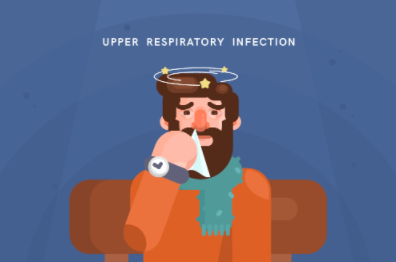An upper respiratory infection, or the common cold, is an infection that affects the nasal passages and throat. Treatment is generally straightforward, unless a person also has a chronic respiratory condition such as asthma.
In order for an upper respiratory infection (URI) to occur, a virus enters the body, usually through the mouth or nose. A person can pass it on through touch or by sneezing and coughing.
Such type of place where people gather in an enclosed space, office, such as a classroom, or own home, can be a high risk place for the spreading of URI.
Typically, a URI lasts 3 to 14 days. In some cases, URI’s can develop into more serious conditions, such as sinus infections or pneumonia.
A URI is an infection that affects the upper airways, including:
- The larynx, which is the muscular organ containing the vocal cords
- The nasal cavity, which is the space above and behind the nose
- The nasal passages or nostrils
- The pharynx, which is the cavity behind the nose and mouth
Adults receive two to three URI’s per year. Babies, especially young children, can experience more because their immune systems are still under developing. Read more
Causes of URI:
There are two possibilities of URI, viruses and bacteria. There are following type of virus which is caused to URI.
- Adenovirus
- Rhinovirus
- Coxsackievirus
- Parainfluenza virus
- Human metapneumovirus
- Respiratory syncytial virus
These viruses can cause to URI let’s discuss the bacteria now which can cause of upper respiratory infection.
- group A beta-hemolytic streptococci
- Corynebacterium diphtheriae (diphtheria)
- group C beta-hemolytic streptococci
- Chlamydia pneumoniae (chlamydia)
- Neisseria gonorrhoeae (gonorrhea)
There are some common types of URI, let’s get a short intro to all of these types of URI.
Common Cold
The common cold is an infection that affects the entire upper respiratory system. A virus attaches itself to the lining of the nose or throat and triggers an immune response. This immune response causes congestion in the local area and leaves your body generally weak as you try to fight it. Usually colds are reason to rhinovirus, but other offenders including flu, parainfluenza and coronavirus.
Pharyngitis
Pharyngitis is the second name of sore throat. Sometimes a sore throat is a symptom of a broader respiratory illness such as the common cold, but it can also be due to an infection only in the pharynx (throat). Possible causes include the strep bacteria, which causes a sore throat, or an infection of the tonsils, known as tonsillitis. In most cases, pharyngitis is due to a viral infection that attacks the throat tissue.
Laryngitis
Laryngitis is often confused with pharyngitis (sore throat), but it specifically refers to an inflammation of the larynx, also known as a voice box. It is usually the result of a viral infection, but it can sometimes occur due to overuse of the voice.
Rhinitis
Rhinitis refers to inflammation in the nasal passages. Rhinitis is generally referred to as allergic or non allergic. Allergic rhinitis is also known as hay fever and is caused by your body’s immune response to certain allergens. Non allergic rhinitis has also the same symptoms.
Final Words
Upper respiratory infection is a common infection which can affect the nasal passage and throat. It usually occurs due to weather change or from environment pollution. There are different types of URI discussed above. You can consult a legitimate online doctor for the instant prescription. This can save yourself or your children more from going away in bad weather condition. This is really helpful and common now a days. Thanks for reading, I hope this is useful for my readers. Keep connected with me I’ll keep you update with latest health news and updates. Stay healthy stay safe!












